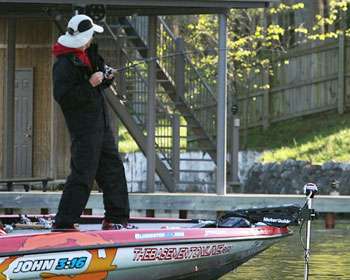
Whether you fish at the Elite Series level or just for weekend enjoyment, maximizing your success on the water depends on the ability to wring every last ounce of fish out of a given area. Even if you've found the ultimate school, no one wants to leave any fish behind.
For top pros like Randy Howell, one way to keep a group of fish riled up and biting is to change lures — either color or style — until he finds a way to trigger more bites. But before changing or slowing down, he'll try to get everything he can in the easiest possible fashion. "When fishing a piece of structure you're familiar with, like a point or a dropoff, you start off with faster-moving baits like crankbaits or, if it's shallow enough, maybe a spinnerbait," he explains.
"If I catch a fish or two that way I know there's fish using that spot." Once he determines that fish are in the area, he'll get all he can out of the moving baits, but eventually the bite will slow, either as the number of fish diminishes or as they become conditioned to his first choice lure.
Then it's time to make a switch. "Sometimes when several fish are there and you show them a crankbait over and over and over again, they get used to it, or they get tired of seeing it," he says. "Then I'll pick up my secondary lure, which is usually a Lunker Lure football jig. "A lot of times, when something new comes through the area, the bass will bite it right away, on the first cast," he says. But eventually that too will likely slow.
Then it's time to show them still another look. "After I throw a lure a few times, I'll pick up different bait. It's all about giving them a new look and not showing them the same thing over and over on the same spot." Of course, all of this assumes that these are resident fish that you're pursuing. If you think that the particular spot is a transition area, then Howell will tend to stick with his first choice, and his second choice, a little longer.
After all, newly arrived fish haven't had time to become jaded or conditioned. In that case, stick with your instincts and the lure that you think fits the conditions best. It can also pay dividends to pay attention to the more subtle clues. If a fish follows your bait but doesn't strike, that tells you that a different triggering agent is needed. Short strikes are another such clue. "On a crankbait bite, if you feel a flick or a thump and it just feels like it hits a fish, then they're slapping at it," Howell says. "Then you know they don't want that and you can pick up a jig or a Carolina rig."
When he's caught what he believes to be all the active fish in a prime area, then Howell's last resort to completely mine the area's potential is a Lunker Lure football finesse head with a Yamamoto Pro Senko as a trailer. "That's the last bait I'll bring in there," he explains. "That'll usually get the last fish to bite, and every ounce helps." One other wrinkle: It's not just different lure types that can trigger additional strikes. Often, a color change can be just as effective as a wholesale switch.
Howell says this is much more applicable to moving lures than with slowly fished soft plastics. "If I know one particular bait that they're biting is a medium running crankbait, then I might start with a craw color, then go to a shad pattern and then maybe chartreuse blue back," he says.
(Provided by Z3 Media)





